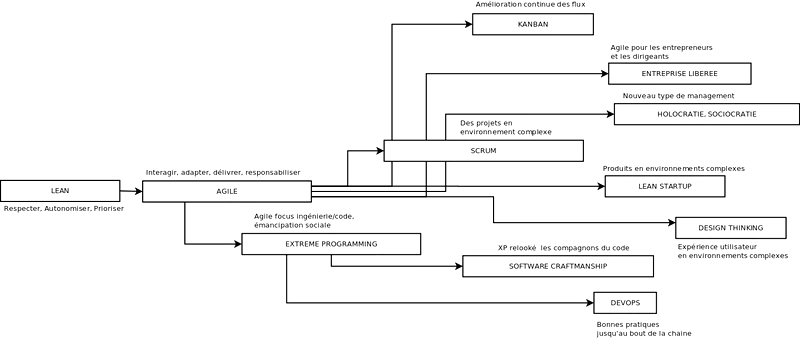As often happens, it’s a conversation and a recurring topic that pushes me to consolidate this short article whose theme aims to be the presentation of movements, methods, agile approaches that we hear about. This is an article aimed more at the novice than the expert, and which absolutely has no ambition to be precise, but rather to give a broad sense to these various names of agility. Because let’s be clear, of all these movements, from design thinking to kanban, it’s the same sensitivity, the same approach behind them. Like Coca-Cola, you have flavors but the base recipe is the same. This multiplicity of names is very understandable. It’s a marketing argument and packaging: we address this or that population in different ways. It’s also an argument for change management: with a new name comes a new right to try, new interest, new distinction.
The agile movements of the Agile movement
The dates proposed are not those of the movement’s creation, but rather roughly of its relevance, and even then, it’s quite vague. The objective is to have more of an impressionist sketch than a figurative one. I’m also very macro or caricatural in the description of movements (XP fanatics will sharpen their knives), once again I’m not trying to be precise, but to give an overall vision.

So what are these flavors and who are they for?
Lean
For methodologists and industrialists, the uncle of Agile when the world was still complicated (and not complex, or was starting to be). We could have added Lean Software, which is the IT counterpart of Lean. Careful with the Lean label: the cowboy hippies.
Agile
Historically for IT and CIOs.
Scrum, Doing complex projects in complex environments.
Kanban Continuous improvement of value creation flows (such as maintenance, a sales cycle, event organization, HR activities, etc.).
eXtreme Programming (XP) Engineering practices and the social emancipation of the developer.
Devops
It’s Extreme Programming where we push the practices all the way to continuous deployment by integrating other populations like infrastructure teams.
Software Craftmanship
We restyle XP and remind people that it takes time and sweat, the code craftsmen.
Lean Startup
Agile for “product” management, for business, ideas, startups. Should have been called Agile Startup but: the cowboy hippies
Design Thinking
Agile with the emphasis on user experience (UX): for designers, creatives, etc. But also business people, product people, very redundant or complementary with Lean Startup itself very complementary to…
Entreprise Libérée
Agile posture for entrepreneurs and managers, vision of the new company.
Holocratie - Sociocratie
Methods to equip self-organization and Agile management in liberated companies. Sociocratie was too hard to carry as a name, so Holocratie or Holacratie wins.
Don’t forget
The base sauce is the same. These are flavors developed to address often different populations who are interested in different entry points. Wild cards to facilitate change management too. In the end, it’s the same approach, the same philosophy, the same paradigm shift. Especially since in a company it would not seem absurd to me that all these movements are present, on the contrary. Even in small companies very quickly several of these movements are necessary.
ps: I say it again, I know that factually Scrum appears before XP, that Design Thinking appears in the 80s, and sociocratie much earlier, etc. etc. But they don’t have the substance we’re talking about now. This little article is not an encyclopedia, it’s an impressionist painting, a silhouette.
Feedback
Sibylle

With this little article I made someone very happy: Sibylle’s mother, who writes to me: “I read your August 14 article to Sibylle, very effective ;-)” Welcome to Sibylle in this complex world. Congratulations to the parents.
Don’t tell the facts, tell the truth
Some question the dates. Did they read and understand my article? More importantly, are they doing a purely analytical reading of things? Unfortunately that’s not enough. A one-dimensional reading, with a single axis, a single perspective. What do we learn in agile: it depends on the context. Some should remember that. Who are we addressing? In what context and for what purpose? Is it the first time the word Scrum is pronounced that counts? The second? Or is it the moment of its true popularity? Has the meme evolved? The method? Once again the purely scientific method, in the absurd analytical sense, fails, at least in my eyes.
It reminds me of this quote: “Tell the truth and not the facts.” (“Tell the truth and not the facts.” Maya Angelou).

Sisyphe
(who like Sibylle above, places the ‘y’ after the ‘i’).
